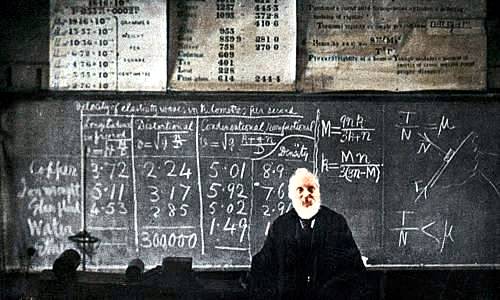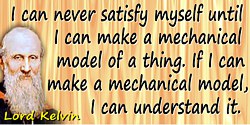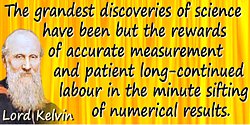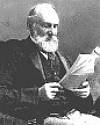 (source)
(source)
|
Baron William Thomson Kelvin
(26 Jun 1824 - 17 Dec 1907)
Irish physicist, mathematician and engineer , born as William Thomson in Ireland, he became an influential physicist, mathematician and engineer who has been described as the Newton of his era.
|
Lord Kelvin
(William Thomson)
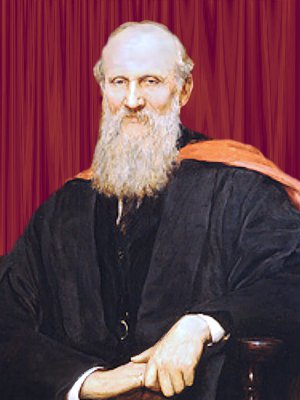
Lord Kelvin
Education: Univ. of Glasgow, then Cambridge.

William Thomson was born on 26 Jun 1824 in College Square East, Belfast, Ireland, the second son of four children. His mother died when he was six, and when aged eight, he moved with the family to Glasgow (1833) where his father, James Thomson, had been appointed as professor of mathematics at the University of Glasgow (1832).
He was an infant prodigy in mathematics, taught by his father until, by age 10, he entered the University of Glasgow in 1834. Guided by his father's interest in his education, Thomson studied at Cambridge University (1841-1845). He then did postgraduate work in Paris with Henri-Victor Regnault, including study of science demonstration techniques. Throughout his education, Thomson demonstrated excellence and published scholarly papers on mathematics, the first when he was 16 ('On the Figure of the Earth', 1840).
When he became Professor of Natural Philosophy at Glasgow University in 1846, at age 22, he held the position for half a century. It was here he would create the first physics laboratory at a British University.
Also in 1846, he estimated the age of the earth—based on creation at the temperature of the sun and the rate of cooling for a body of the size of the earth—to be around 100 million years. It was only later that there was knowledge of the heating effect of the radioactivity in the earth’s core. So, he stubbornly defended this calculation throughout his life, and contested Darwin’s conclusions on evolution as impossible in the time period.
Kelvin’s other interests in heat, though, were productive and correct. He first defined the absolute temperature scale in 1848, subsequently named after him, which was the first scale based on a completely general natural law. In the same year, still in his early 20’s, he was made a member of the Royal Society.
In 1851 he published ideas leading to the second law of thermodynamics and supported his friend James Joule’s mechanical equivalent of heat. He changed the view of heat as being a fluid to an understanding of the energy of motion of molecules. The term “kinetic energy” was coined by Thomson in 1856. The names of these two scientists are linked with the famous Joule-Kelvin Effect (1852) which makes refrigerators work. Kelvin's name is also immortalized by the Kelvinator fridge.
While at Cambridge, Thomson had published 'The Uniform Motion of Heat in Homogeneous Solid Bodies, and its Connection with the Mathematical Theory of Electricity,' (Cambridge Mathematical Journal, vol. iii. 1842.) By applying this analogy of heat flow to the flow of electricity, in 1854, he joined Cyrus Field’s efforts to lay a transatlantic telegraph line. He improved the design of the cables, even traveled on the ships supervising the laying of them.
This experience prompted Kelvin’s invention of the mirror galvanometer (patented 1858) as a long distance telegraph receiver which could detect extremely feeble signals. He studied the electrical losses in cables, and improved the mariner's work with the invention of an improved gyro-compass, new sounding equipment, and a tide prediction with chart-recording machine. He also introduced Bell’s telephone into Britain.
He stayed with the transatlantic cable project despite problems, setbacks and the need to restart more than once. With the breadth experience acquired, he now became wealthy from consulting on the subsequent submarine cable projects of others.
Thomson published more than 600 scientific papers and filed a total of 70 patents. He was the president of the Royal Society from 1890 to 1895.
In 1866 he was knighted because of his achievements in submarine cable laying. In 1892 he was raised to the peerage as Baron Kelvin of Largs, which title he chose from the Kelvin River, near Glasgow. He was Britain's first scientific peer.
Late in life, he resisted the new scientific revolution that was beginning, so different from the science he knew:
When he died in 1907, he was buried next to Isaac Newton in Westminster Abbey.
- Science Quotes by Baron William Thomson Kelvin.
- 26 Jun - short biography, births, deaths and events on date of Kelvin's birth.
- A Kelvin Biography - with more background on Kelvin’s early scholarship in mathematics and his life’s work, from Famous Men of Science.
- William Thomson Kelvin - context of quote “Make a mechanical model” - Medium image (500 x 250 px)
- William Thomson Kelvin - context of quote “Make a mechanical model” - Large image (800 x 400 px)
- William Thomson Kelvin - context of quote “Many of the greatest advances” - Medium image (500 x 250 px)
- William Thomson Kelvin - context of quote “Many of the greatest advances” - Large image (800 x 400 px)
- William Thomson Kelvin - context of quote “The rewards of accurate measurement” - Medium image (500 x 250 px)
- William Thomson Kelvin - context of quote “The rewards of accurate measurement” - Large image (800 x 400 px)
- William Thomson Kelvin - context of quote “I have no satisfaction in formulas” - Medium image (500 x 250 px)
- William Thomson Kelvin - context of quote “I have no satisfaction in formulas” - Large image (800 x 400 px)
- William Thomson Kelvin - context of quote “Mathematics is … etherealisation of common sense” - Medium image (500 x 250 px)
- William Thomson Kelvin - context of quote “Mathematics is … etherealisation of common sense” - Large image (800 x 400 px)
- William Thomson Kelvin - context of quote “Measure … and express in numbers” - Medium image (500 x 250 px)
- William Thomson Kelvin - context of quote “Measure … and express in numbers” - Large image (800 x 400 px)
- William Thomson Kelvin - context of quote “Imaginary difficulty of making a change” - Medium image (500 x 250 px)
- William Thomson Kelvin - context of quote “Imaginary difficulty of making a change” - Large image (800 x 400 px)
- William Thomson Kelvin - context of quote “Questions of personal priority” - Medium image (500 x 250 px)
- William Thomson Kelvin - context of quote “Questions of personal priority” - Large image (800 x 400 px)
- William Thomson Kelvin - context of quote “Science is not antagonistic to religion” - Medium image (500 x 250 px)
- William Thomson Kelvin - context of quote “Science is not antagonistic to religion” - Large image (800 x 400 px)
- William Thomson Kelvin - context of quote “Simplification of modes of proof” - Medium image (500 x 250 px)
- William Thomson Kelvin - context of quote “Simplification of modes of proof” - Large image (800 x 400 px)
- William Thomson Kelvin - context of quote “Mathematics is the only true metaphysics” - Medium image (500 x 250 px)
- William Thomson Kelvin - context of quote “Mathematics is the only true metaphysics” - Large image (800 x 400 px)
- Excellent Kelvin Biography history at the BBC education site for the Local Heroes TV series.
- Construction details for "Kelvin's Thunderstorm" - Lord Kelvin's water-drop electrostatic generator..
- Kelvin at three different ages - a photo gallery across his life.
- Collection of pictures of Kelvin at different ages - at the MacTutor site.
- Informative Biography of Kelvin - with additional resources at the MacTutor site.
- History of Submarine Cables - a 150 Year History of Submarine Cables.
- Timeline of Atlantic Cables - 1856 to 2015.
- Lord Kelvin's Conjecture Disproved - A modern improvement on Kelvin's 1887 geometrical conjecture.
- Degrees Kelvin: A Tale of Genius, Invention, and Tragedy, by David Lindley. - book suggestion.
- Booklist for William Thomson.
